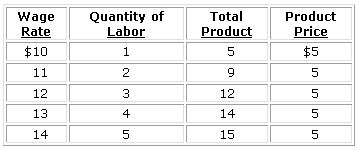 |
| 1 |  | 
Use the following diagram to answer the question. <a onClick="window.open('/olcweb/cgi/pluginpop.cgi?it=jpg::::/sites/dl/free/0073511455/991477/image.jpg','popWin', 'width=NaN,height=NaN,resizable,scrollbars');" href="#"><img valign="absmiddle" height="16" width="16" border="0" src="/olcweb/styles/shared/linkicons/image.gif"> (14.0K)</a> <a onClick="window.open('/olcweb/cgi/pluginpop.cgi?it=jpg::::/sites/dl/free/0073511455/991477/image.jpg','popWin', 'width=NaN,height=NaN,resizable,scrollbars');" href="#"><img valign="absmiddle" height="16" width="16" border="0" src="/olcweb/styles/shared/linkicons/image.gif"> (14.0K)</a>
Refer to the diagram. Initially, labor demand is given by D1. A move from D1 to D3 could be caused by either: |
|  | A) | an increase in labor productivity or a decrease in the wage rate. |
|  | B) | an increase in the price of a complementary input or a decrease in the wage rate. |
|  | C) | a decrease in the price of a substitute input or a decrease in the wage rate. |
|  | D) | an increase in labor productivity or an increase in the demand for the product this labor is helping to produce. |
|
|
 |
| 2 |  | 
Which of the following best exemplifies the creation of human capital? |
|  | A) | Ford Motor Company increases its wages in an attempt to hire better quality workers. |
|  | B) | A carpenter buys a new and improved set of tools. |
|  | C) | A nurse attends a continuing education seminar. |
|  | D) | A homemaker reenters the labor force following the entry of her last child into school. |
|
|
 |
| 3 |  | 
The "derived demand" concept suggests that an increase in the demand for computers will: |
|  | A) | increase the demand for computer software. |
|  | B) | decrease the demand for typewriters. |
|  | C) | increase the price of computers. |
|  | D) | increase the demand for computer design engineers. |
|
|
 |
| 4 |  | 
An increase in the price of jet fuel increases the cost of airline travel and reduces the demand for airplane mechanics. This decrease in labor demand would be caused by which change in a determinant of labor demand? |
|  | A) | A fall in labor productivity |
|  | B) | An increase in product demand |
|  | C) | A decrease in product demand |
|  | D) | An increase in the price of another resource |
|
|
 |
| 5 |  | 
Consider a single firm hiring labor from a purely competitive labor market. If the supply of labor increases in the market, the firm's labor: |
|  | A) | demand will increase and it will hire more workers. |
|  | B) | demand will decrease and it will hire fewer workers. |
|  | C) | supply will shift downward and it will hire more workers. |
|  | D) | supply will shift upward and it will hire fewer workers. |
|
|
 |
| 6 |  | 
Use the following data to answer the question. <a onClick="window.open('/olcweb/cgi/pluginpop.cgi?it=jpg::::/sites/dl/free/0073511455/991476/weba_q6.jpg','popWin', 'width=NaN,height=NaN,resizable,scrollbars');" href="#"><img valign="absmiddle" height="16" width="16" border="0" src="/olcweb/styles/shared/linkicons/image.gif"> (22.0K)</a> <a onClick="window.open('/olcweb/cgi/pluginpop.cgi?it=jpg::::/sites/dl/free/0073511455/991476/weba_q6.jpg','popWin', 'width=NaN,height=NaN,resizable,scrollbars');" href="#"><img valign="absmiddle" height="16" width="16" border="0" src="/olcweb/styles/shared/linkicons/image.gif"> (22.0K)</a>
Refer to the table, in which the first two columns constitute the firm's supply of labor and the last three columns contain productivity and product demand data. The profit-maximizing wage rate for this firm is: |
|  | A) | $10. |
|  | B) | $11. |
|  | C) | $12. |
|  | D) | $13. |
|
|
 |
| 7 |  | 
All else equal, the demand for labor will be most elastic when labor and capital are: |
|  | A) | highly substitutable and product demand is elastic. |
|  | B) | highly substitutable and product demand is inelastic. |
|  | C) | not easily substitutable and product demand is elastic. |
|  | D) | not easily substitutable and product demand is inelastic. |
|
|
 |
| 8 |  | 
Many economists do not support an increase in the minimum wage, arguing that such an increase would likely: |
|  | A) | reduce the demand for skilled labor. |
|  | B) | create a labor shortage. |
|  | C) | increase the size of the government's deficit. |
|  | D) | increase unemployment of low-wage workers. |
|
|
 |
| 9 |  | 
The fundamental trade-off faced by unions is that an increase in the wage often results in: |
|  | A) | increased inflation. |
|  | B) | lower employment of union labor. |
|  | C) | reduced future bargaining power. |
|  | D) | reductions in the demand for their employer's product or service. |
|
|
 |
| 10 |  | 
Other things equal, the demand for labor will be more elastic: |
|  | A) | the greater the demand for the product. |
|  | B) | the more substitutable that labor is with other inputs. |
|  | C) | the higher the price of capital. |
|  | D) | the smaller the elasticity of product demand. |
|
|

